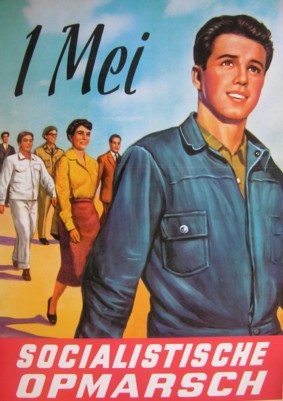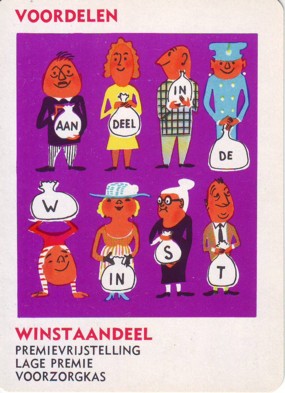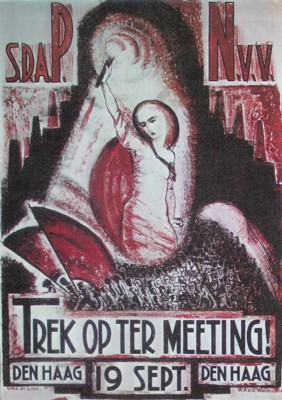
Figure 1: Poster of BSP
Although group processes are often ignored in economics, it is known from sociology and psychology that they do exert influence. The economist R.H. Coase has already pointed to the costs of the operation of markets and organizations. Recently, among others the economist P. Frijters and the sociologist J.S. Coleman have elaborated on this phenomenon. The present column describes the group dynamics with the help of the book of D.R. Forsyth. Discussed are leadership, the influence of group norms, decisions, and conflicts within the group and between groups.
Already since its foundation, the Gazette studies the interaction between the economic and social processes, following its name-giver Sam de Wolff. Two publications have inspired these discussions, namely An economic theory of greed, love, groups and networks (in short GLGN) by the economist P. Frijters, and Foundations of social theory (in short ST) by the sociologist J. S. Coleman. Both works are clearly related, not only due to their liberal tone, but also due to their methodological approach1. The message of this socio-economic direction is, that the economy can not be understood as purely an exchange of goods on the markets. The right insight requires an analysis of sociological and psychological influences on the economic process.
This becomes obvious when an inventory is made of the production factors. Firstly, there are the well-known economic factors: raw materials, labour, capital goods, and human capital. Here the human capital refers to personal properties, which increase the labour productivity (in short l.p.). The generation of human capital is partly determined by the social institutions. Consider education and the like. However, there are also production factors, that yield the right conditions, namely the entrepreneurial network, the social capital, and the institutions (see p.269 in GLGN). The present column will further elaborate on these conditional factors.
The trade and industry consist of a network of enterprises, which encompasses the totality of all markets. The enterprises form the nodes in the network, and they are mutually connected by relations or contacts. It is obvious that the goal of the contacts is to realize a profitable exchange of commodities (where the commodities consist of goods and services). The enterprises become true contact makers because of their need for such relations. They are inspired by the entrepreneurial spirit. Since the enterprise wants to select the most profitable relations, the making of contacts causes search costs. This is called market friction. Note that in this model the analysis begins at the micro level, an approach that is adopted by both GLGN and ST. Markets and networks aim at economic transactions, and therefore require freedom. The network is not actively dedicated to a single system of norms and values.
Nevertheless, the enterprises benefit from restricting the risks in their transactions. This is desirable in order to insure the future existence of the enterprise. When a relation is formed, then the concerned enterprises accumulate a mutual informal trust. This is part of the mentioned social capital. It may be clear, that the "density" of the network and the generally available trust are correlated. Nevertheless, such a trust offers merely a limited certainty. Therefore institutions will be established, which have the task to regulate the markets. The institutions formulate laws, rules and norms, and enforce the obedience by punishing infringements. They serve the general (collective) interest. Thus the network yet generates morals, but via the indirect path of the institutions2.
Note that the general interest is a concept, that refers to the macro level. The individual interests are aggregated. The highest body within the hierarchy of institutions is the national state. The network of enterprises wants to keep a maximal degree of freedom, and therefore wants to control the state. Historically the influence has taken on the form of the political democracy. When the government functions poorly, then it can be replaced by a better one. Thus the parliamentary system is not a hierarchy, but a reciprocal circle, based on voluntariness. Nevertheless, the state and other institutions can only perform their task, as long as they dispose of power. Each reciprocal circle obtains its power, because its members collectively promote the goals of the circle.

Both circles and hierarchies are groups of people. The preceding argument expresses several important differences between the network and the group. The group disposes of its own morals. Moreover, since the group members commit themselves to the group morals, the group has a relatively large power3. Now this makes the group attractive for individuals, because they can mobilize that power in order to realize their own goals. In advance it is evidently uncertain, whether the group will truly commit herself to the private interests of an individual. The individual merely has an expectation of the future utility, which the membership of the group will give him. And against this utility there is the costs of the membership, such as the obedience to the group morals. Apparently joining the group is always an act with uncertain consequences. It is a speculative exchange.
Since joining the group is a subjective choice, here the GLGN assumes that the new member feels love (dedication). He is willing to make sacrifices in order to make his group prosper4. Once more, the group power is one of the benefits of the membership. However, this must be interpreted in a broad sense. For instance, a group allows for the spreading of various risks among its members. The groups allows to escape from the unbridled competition of the market. That yields security. And groups spread information among their members. Furthermore, learning processes in groups are more efficient than in isolation. For these and other reasons groups succeed in increasing the production l.p. per capita above the level of each individual separately. In short, actually the participation in groups is a life necessity for individuals.
The informal trust offers some security. For instance, in an oligopoly there commonly form silent understandings, that prevent a struggle of life and death. But that equilibrium remains fragile. Therefore it is not surprising, that the network of markets is replete with groups. The following reciprocal circles can be found, among others: associations of entrepreneurs, professional associations, trade unions and their federations, consumer organizations, joint ventures, cartels, and the branch organization or product chain. These circles are already fairly stable. The hierarchy can also be found, notably the enterprise and the trust. Note that circles with a task of public law, such as the state or the corporation, can exert coercion. Thus they contain elements of the hierarchy.
It is worth mentioning that already in 1937 the economist R.H. Coase pointed to the group formation as an alternative for the use of markets5. For, on the market the enterprise must make transaction costs, notably because al lot of information must be collected, and because contracts must be concluded with suppliers and buyers. When those costs are high, then it can be beneficial to include the suppliers or the buyers in the enterprise. Then the use of markets is replaced by the organization of the production within the enterprise itself. The information is directly available, and the contracts are replaced by hierarchical commands. The organization within the enterprise naturally also causes costs6. Thus the enterprise must base the arrangement of its production process on an evaluation of the costs of, on the one hand, markets, and, on the other hand, its own organization.
This model of Coase once more underlines the importance of understanding the interactions within the group. For, they determine the costs, when the enterprise chooses to use ownership instead of markets. The production costs depend on various social phenomena within the production process. The organization within the enterprise is not purely a hierarchy, but also contains many reciprocal groups. Certainly during the past decades the enterprises strive after self-managing teams, with a personal responsibility7. Here an important subject of economic research is the principal-agent problem. The sociology and psychology yet identify various additional problems.
In this manner the various social sciences create a fascinating and curious dilemma. On the one hand, the economy couples the optimal choice for a certain group structure to the just described costs-benefit analysis. On the other hand, the sociology and psychology conclude, that the structure of the group affects its members. The group dynamics, in turn, affects the calculation of the costs and benefits, and its consequences are difficult to predict. Already in 1961 the Dutch economist J. Pen has described various group processes in a qualitative way, in his book Harmonie en conflict8. But only during the last decade, economists such as Frijters present truly advanced models of economic groups. Your columnist believes that it is worthwhile to reflect on such group processes.
The Gazette has previously paid attention to the insights of happiness economics and of behavioural economics. The present column is based on the discipline of group dynamics, a part of social psychology, notably the book Group dynamics by the psychologist D. R. Forsyth9. The text contains referrals to pages in this book, in order to avoid an abundance of footnotes. In the following paragraphs the column focuses on phenomena, which seem relevant for economics. Each paragraph is concludes with an attempt to relate the presented knowledge to the concrete economic groups and organizations.
The group structure is the pattern of relations between the members (p.109). It is in part determined by the goal of the group and the corresponding division of labour. Some goals require more centralization and direction than others (p.221). The following elementary structures of ties between group members are distinguished, among others: the wheel (with as a special case the inverted Y), the chain, and the circle (p.130). Each function or role (node, link in the web of the group) has a task aspect and a socio-emotional aspect (p.236). Thus each group creates her relations of authority, where the status of each member is decisive (p.118).

Centralization is often effective. The leading centre coordinates the activities (p.212) The status is accompanied by certain expectations of the group, and that holds extremely with regard to the leader. Notably, the group members expect from him, that he guides them to a good performance (l.p.)10. The performance is a team-work of the direction and her group (p.215, 225). There is a reciprocal, interpersonal exchange11. So the direction does not automatically and forever have an absolute power to act. She must reinforce her position by accumulating credit points (p.156), for instance by being involved (p.226). Apparently it is desirable, that the leader remains accessible for the group (p.217). The group wants to feel recognition towards her leader (p.227). A good leader becomes a role model for his group members, and can inspire them to follow him (p.185). He builds up trusts and elicits dedication12.
Authoritarian leadership can enforce a high productivity, but it creates discontent and aggression within the group (p.44, 192, 242). Such tensions can escalate. Too much power may incite the leader to abuse it (p.197). Finally, an open rebellion may occur13. Democratic leadership encourages cooperation. Especially, knowledgeable members like to participate in the leadership (p.243).
Here follow several examples of centralization:
It has just been remarked that being a member of a group has advantages for the individual (p.50). The group must satisfy the needs of her members (p.65). A strong coherence makes the group more stable (p.54) and therefore also mightier. In previous columns the concept of power has already been elaborated. Note that power, authority and influence are comparable concepts (p.180)15. The group supplies a reference point to her members, which allows them to evaluate and value their own situation (p.40, 56, 164). The individual morals adapt to the group. This is especially true, as long as the group is successful, that is to say, realizes her goals (p.68). During the period of adaptation the attitude of a new member can conjure up friction and conflicts, but all in all these commonly contribute to the mutual involvement (p.79, 92, 97)16. This is called a role negociation (p.97).

Reversely, the shared morals will reinforce the identity of each member (p.58). Then a feeling of security grows. The norms are maintained by group pressure (p.142). The pressure rises according as more members bear the concerned norm (p.149). Often the members indeed internalize the group norm (p.162). Sometimes a member adapts his vision against his better judgement (p.148). But a persevering minority can exert a counter-pressure (p.151, 165). This illustrates the reciprocity, and in addition can stimulate innovation. Rebellion does undermine the popularity of the minority (p.167). For, coherence improves the relation.
Nevertheless, such a coherence is not always a guarantee for a high productivity (l.p.) (p.87)17. This deserves attention, because the group justifies her existence with the supposed increase of the personal peformance (besides the supply of norms) (p.252). It is true that company incites to improve the performance, especially in routine tasks. This is called social facilitation. It is suspected, that in groups the information is better digested, or that each person tries to create a good reputation18. The l.p. is obviously also increased by a smart division of labour (p.261). This partly depends on the type of goal of the group.
It is remarkable that sometimes groups decrease the l.p. (p.269). This occurs in badly functioning groups, and is caused by process losses. For instance, the coordination can fail. But there is also the phenomenon of social loafing, sometimes because everybody believes that his own contribution is negligible. The sense of responsibility is missing. The loafing can be reduced by good labour morals, which are maintained by group pressure (p.273). Everybody must feel responsible (p.280).
Yet another hallmark of groups is the spatial proximity (p.324). Groups mark out their territory. The ties between neighbours is sometimes also strengthened, notably when there is a mutual inclination to cooperate (p.334). That is to say, the nature of the mutual relation determines to what extent proximity is tolerated. The experienced distance is subjective (p.342). It is obvious that groups can be discontinued, as soon as they are no longer satisfactory or needed (p.88). Organization developers can manage the processes in the group during the various phases of her existence (p.100, 230). Here, sometimes group participation is employed19.
Here are some examples of group influences:
It is commonly assumed that groups make qualitatively better decisions than individuals. Various irrational views are suppressed by the averaging (p.263). On the other hand, the group decision can not be better than that of its experts. When the group decision is composed of partial decisions, for instance in a chain, then the weakest link determines the quality of the whole (p.266). The group must take this into account, when the decision is decentralized. Furthermore, the process of deciding must be determined (p.291). The simplest form delegates the decision to the leader. However, the support is larger, when it is attempted to reach consensus. Unfortunately, this sometimes will require group pression. Sometimes this will lead to self-censorship, or people are urged, or prejudices grow.
Thus the decisions can become irrational, a phenomenon that is called group-think (p.298). This threatens in particular, when the group is highly cohesive and is isolated. Other causes are a poor leadership and a strong external pressure, for instance due to time. It is remarkable that a group with a poor cohesion often benefits from deciding under time pressure (p.302). That gives exactly the impulse, that allows to break through the heterogenity. Another striking phenomenon is the group polarization (p.308). That is to say, in the process of deciding the group is inclined to reinforce her preferences. The more moderate members get carried away by the more radical members. Counter-arguments are no longer heard due to the isolation. Thue the group can prefer risks (risky shift), or entrench herself.
Forsyth does not discuss the fact, that even a successful execution of a decision can yet result in a disappointment. For, in the introduction it has already been remarked, that the new situation can itself affect the cognition. Therefore the expectation in advance can clash with the experience afterwards21. The group will naturally prefer to avoid that disappointment, and therefore she is inclined to yet justify the decision in retrospect. This attempt to avoid dissonances also requires a restructuring of the cognitions22.
Here follow several examples of decisions:
The paragrahp about leadership has already shown, that conflict is stimulated by competition, threat, and manipulations (p.353). Competition often coincides with an order, such as the hierarchy. Sometimes a function or role in the group is defined poorly, sho that tensions and conflicts arise (p.115). The game theory shows, that in a situation with competition the group sometimes does not make the optimal decision (p.357)23. When an actor chooses for cooperation, he runs the risk of being exploited by a competitor. A familiar example is the so-called tragedy of the commons. Consider for instance over-fishing by fishing-villages.
Competition stimulates the formation of prejudices among both actors. This undermines the coherence of the group, and the interactions become less rational (p.366). Sometimes the competitive players try to increase their power by forming coalitions within their group (p.371). Thanks to the coalition the player expands his choice alternatives24. Coalitions are often temporary, because their composition is homogenous. In other words, the partners are united by just a single interest25. Attempts to solve a conflict can also employ communication and deliberations, but these require time (p.381). This implies searching for a compromise26. Special cases of decisions are the arbitrage and the mediation.
Here are some examples of conflicts within a group:

The relation between groups has the special hallmark, that competition is natural. Groups tend to place each other in a certain category (p.411). This is a simplified picture of reality, which makes the outside world easier to understand. The prejudices or biases base on cognitive generalizations, called stereotypes (p.406). The disadvantage is obviously, that important nuances are ignored. The reality is distorted to such an extent, that discrimination can occur. This is called an attribution error of the group (p.408). A consequence is that the expectations about the other group lead to a personal behaviour, that stimulates the realization of the expectation. This process also escalates.
The preceding paragraph has described how conflicts between individuals or sub-groups within a group can emerge. When two groups become involved in a conflict, then similar social mechanisms occur as during competition between two individuals. However, now the fight over the conflict will be vehement. For, there is no bond between the groups. The groups themselves become more coherent, and the leader gains in power, due to the external threat (p.394, 400). Sometimes a double standard is used for the personal group and the other one (p.412). This is evidently injust. There is a significant danger, that the conflict will escalate and turns into a downward spiral of competition. When one of the groups really subjects the other one, then this generally undermines the productivity of both (p.399).
Serious conflicts between groups can not simply be solved by means of deliberations (p.414). On the contrary, that interaction can stiffen the discord. Reconciliation becomes only possible, when the two groups discover a shared interest, which requires their combined effort. But even then it is a long-lasting and difficult process (p.416). Many negotiations will be needed. It also helps, when the groups take on a more open attitude. But certainly when one of the two groups is clearly the weakest, then she will remain suspicious for a long time27.
The argument in this paragraph holds for many types of groups. However, it is fascinating to check whether stereotypes and biases affect the operation of markets. Here are several examples of conflicts between groups:
It turns out that the personal cognition is affected by social pressure from the group. Thanks to his identification the individual benefits from the knowledge and information, that is present within his group. Unfortunately, thus the personal cognition is changed somewhat, and subjected to biases. That has consequences for the model of Coase, because apparently the economic analysis of costs and benefits is irrational. Thus it is not guaranteed, that the most efficient structure is indeed chosen for the economic order.